Completion of the 1915 campaign of the year on the Russian front: the battle for Lutsk and Chartoryisk. Operation on the river. Strypa
An important role in this operation was played by the cavalry. In order to facilitate the operation of Smirnov’s 2 Army, it was decided to concentrate all the cavalry on its right flank. The 6 Cavalry Corps of Oranovsky (19 and 1 Cavalry Divisions) was sent here by forced marches to 8 (14) in September. He had to, following Molodechno and Krivichi, throw the German cavalry to the west, cover the Vileyka-Polotsk railroad and re-establish contact with the 5 army. In addition, the mass of Russian cavalry hung over the base of the German wedge, showing that it could itself go into enemy rears. In order to strengthen the cavalry grouping, the Consolidated Corps of Tumanov (6-I and 13-I cavalry divisions) was transferred to Oranovsky subordination. As a result, an entire cavalry army from 2 cavalry divisions (4 thousand sabers) was actually concentrated on the right flank of the 10 army.
At the same time with the Oranovsky group in the Polotsk direction, another strong cavalry detachment was formed. The headquarters considered that the Potapov detachment operating in the Polotsk area could not reliably cover the city. Therefore, the 3 Don Cossack Division was sent to help him from the South-Western Front. She landed in Polotsk 7 (20) September. The division commander of Belozersky-Beloselsky was subordinated to Potapov’s detachment. This cavalry group was supposed to reliably cover the approaches at the site of Drissa, Polotsk. The Driss site, Disna, covered another cavalry detachment of General Kaznakov.
Thus, the Russian command responded to the breakthrough of the German cavalry by creating a powerful cavalry group, which, together with all the troops, was in fact a cavalry army. It was a good move.
With 8 (21) September, the Russian cavalry began to actively operate at the junction of two fronts. Oranovskogo group was advancing to the north-west, crowding the 4, 1 and 3 guards cavalry divisions of the enemy. The Belozersky detachment, moving from Polotsk to the west, rejected the 9 th cavalry division of the Germans. The Kaznakov cavalry detachment (1-I Guards and 5-I cavalry divisions, Ussurian Cossack brigade), striking south-west, pushed the Bavarian division. By the combined efforts of the Russian cavalry, the cavalry of the enemy was ousted west of the Pasta. Cavalry detachments came in contact with each other and restored the communication of the Northern and Western fronts. As a result, the breakthrough of the enemy troops was eliminated.
To combine the actions of several cavalry detachments, it was decided to put them under the command of General Oranovsky. As a result, a cavalry group was created as part of the 1 Cavalry Corps, the Consolidated Corps of General Tumanov, Kaznakov Detachment, 3 of the Don Division and Potapov Detachment. The Oranovsky cavalry army actually had three cavalry corps (8,5 divisions) with 17 horse batteries (117 guns). The Russian cavalry was to continue the offensive, breaking through the German front near Sventsyany for a subsequent attack to the rear of the Dvina enemy group or a deeper invasion in the direction of Wilkomir and Ponevezh.
16 (29) September, the cavalry of Oranovsky continued the offensive. At the same time, the 1 Army and the 1 Siberian Corps of the 1 Army of the new composition began to move into this sector of the front. By the evening of September 19 (October 1), the infantry changed their cavalry, which they took to the second echelon. With the release of the cavalry of Oranovsky and the 1 Army in the Polotsk sector, the flanks of the Northern and Western fronts were finally closed. At the same time, the German command regrouped from Dvinsk to the south and from the river Viliya and Lake Naroch to fill the junction between the flanks of the Neman and the 10 armies.
As a result, the idea of the German command was completely disrupted. The attempt of the German troops to surround and destroy the main forces of the 10 of the Russian army failed. The German troops successfully chose the site of the strike, successfully launched the operation, but they could not crush the Russian troops. The Russian command quickly responded, skillfully retreating the front forces, formed first army (2-th new formation), then the second (1-th army of the new formation), as well as the cavalry group - actually Oranovsky equestrian army. The counterstrike of the Russian troops eliminated the gap between the two Russian fronts. True, the German army was able to occupy new territories. The Russian armies withdrew to the line the river Western Dvina, Dvinsk, Vileika, Baranavichy, Pinsk. Front stabilized.
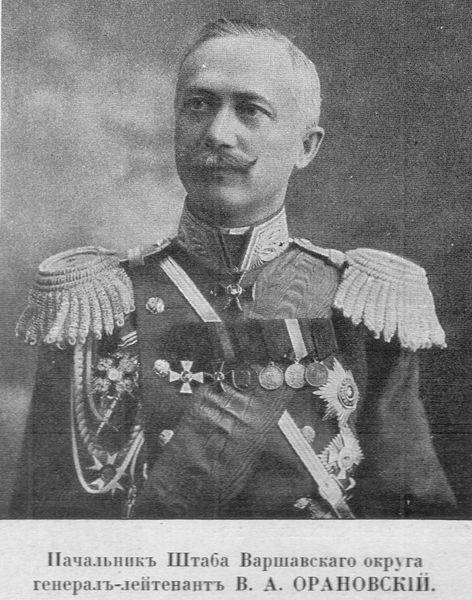
Commander of 1 Cavalry Corps Vladimir Aloizievich Oranovsky
Completion of the 1915 campaign of the year on the Eastern Front
Battle for Lutsk. The Austrian command refused to further attempts to attack along the valleys of the Vistula and Bug rivers. It transferred the main efforts to Sarny and Lutsk. There, from the left flank, the forces of the 1 and 4 of the Austrian armies regrouped. However, the Austrian troops did not achieve noticeable results.
Autumn operations on the South-Western Front were also limited and did not lead to a significant success of one of the parties. At the beginning of September, 1915 of the Battle of Vishnevtsy and Dubno, Brusilov's 8 Army defeated the opposing 1 and 2 Austrian-Hungarian armies.
General Brusilov, reflecting the blow of the enemy, turned to the headquarters. Proved that if he was given reinforcements, the 8-I army will be able to defeat the northern flank of the Austro-Hungarian army. He rested in the forest, and the Austrians had a weak cover here. They believed that large-scale hostilities in the area are impossible. This proposal was received by Brusilov at the time of the enemy's breakthrough at Sventsyanami, when every regiment was on the score. However, Alekseev appreciated this opportunity. If you defeat the Austro-Hungarian troops, the Germans will again have to rescue them, divert forces from the main direction. In 8, the army sent a fresh corps under the command of General Zayonchkovsky (the future prominent military historian). They decided to strike the blow at Lutsk.
16 September, our troops launched an offensive. 30 Corps and 7 Cavalry Division advanced on the northern flank, 39 Corps, 4-I Iron Division and 8 Corps on the southern flank. Denikin's iron infantry broke through the front and on September 18 came out to Lutsk from the south. Started storming the city. However, the city was fortified by the Russians before the war. In Lutsk, Austrian divisions with a large number of artillery settled in 2,5. Therefore, Denikin's division was met with a hurricane of fire. She was able to capture some of the enemy’s positions, but then she was stopped.
Then, from the north to the city, the 30 body of Zayonchkovsky broke through. However, to take the city on the move failed. The Russian troops, having broken from both sides to Lutsk, took a large part of the Austrian 4 into ticks. The Austro-Hungarian command removed the troops from the possible "boiler", and for this it was necessary to keep the city. The Austrians stubbornly resisted. The attacks of the 30 Corps were repelled. Russian troops spent ammunition. There was nothing to respond to the powerful fire of the Austrian artillery. Then Denikin called the regimental commanders and said: "Our position is peak, Nothing remains as to attack." September 23 Denikin's troops with a sudden attack broke into the city. For them rushed troops 30-th corps. The city took.
The victory was significant. Only Denikin's division captured 10 thousand people. Several Austrian units that did not have time to retreat were surrounded. The Austrians surrendered en masse. 4-I Austrian army, which was considered the best in the Austro-Hungarian army, suffered a heavy defeat. The northern flank of the Austrian front was in jeopardy. The Austrian command asked for help from the Germans. Falkenhain had to remove one corps from Belarus to help the Austrians.
Russian intelligence discovered the approaching German troops. Brusilov directed against the Germans 30 Corps, 4-th Iron and 7-Cavalry Divisions. However, the headquarters of the South-Western Front intervened and ordered to leave Lutsk, and to withdraw to the old positions. At the same time, the troops of Zayonchkovsky and Denikin were to arrange an “ambush” for the Germans from the forests. It was believed that the Germans were fascinated by the persecution and the “ambush regiment” would strike from the rear. However, excessive ingenuity led to failure. Brusilov’s objections were not taken into account. As soon as our troops began to withdraw, the Austrians cheered and counterattacked. We had to retreat in difficult terrain and with heavy rearguard battles. It was not possible to hide a mass of troops from 4 divisions in the forest. The Germans were not fools and found an “ambush”. Began a hard head-on fight. In the bloody battles, the Russian and German troops povibili each other, lost up to 40% of the personnel. Weakened, both sides went on the defensive. So, Lutsk was left for the enemy. The only positive result of the offensive of Brusilov’s army was the diversion of German troops from the main line.
Chartoryisk. Almost across the front, positional defense was built with 2-3 reinforced strips, each with 3-4 trenches with machine-gun nests, dugouts and wire barriers. But in Polesie between the South-Western and Western fronts left a "window". German troops who stood against Brusilov’s 8 Army near Lutsk decided to take a more advantageous position and in October advanced north along the river. Styr and occupied the town of Chartoryisk.
Brusilov, fearing a strike on his right flank, decided to strike at the enemy. Just at that time reinforcements arrived - the 40 corps. He suggested that the front command allocate additional forces to him and conduct a serious operation, defeat the left flank of the Austro-German front, break through to Kovel. However, the front commander Ivanov did not believe in the success of such an offensive and did not give reserves. At that time he was afraid that the enemy would break through to Kiev and have to leave him. Things reached the point that in 300 km from the front, on the Dnieper, large-scale works were carried out to build fortifications.
Therefore, Brusilov decided to carry out a limited operation, knock out the Germans from the area of Kolka, Chartoryisk, and improve their positions before the onset of winter. October 16 our troops launched an offensive. The 30 Corps tried to break into the Pegs. But here battles were fought back in September and the enemy’s success was well established. Break through the defense failed. But to the north, under Chartoryi, the Germans had not yet managed to thoroughly strengthen. Voronin's 40 Corps managed to secretly advance through forests and swamps. Attacks did not expect. The Russians suddenly broke through the Styr River and attacked the enemy. They broke through the enemy defenses, dived 20 km, and 18 October took Chartoryysk.
Denikin's 4 Division rushed into enemy rears. The Austrians and Germans came to their senses and began to send reinforcements to the place of the breakthrough. But Brusilov had no reserves, there was nothing to build on success. The Austrians threw against the 4 regiments of Denikin 15 regiments. On advancing, the Russian regiments broke away from each other, fell into a semi-circle. The commander of the regiment Markov reported by telephone: “A very original position. Fighting on all four sides. It is so difficult that it is even fun! ”However, Denikin was able to assemble the scattered parts and withdraw the troops back. The German and Austrian troops for some time tried to repel Chartoryisk, but to no avail. Both sides went on the defensive.
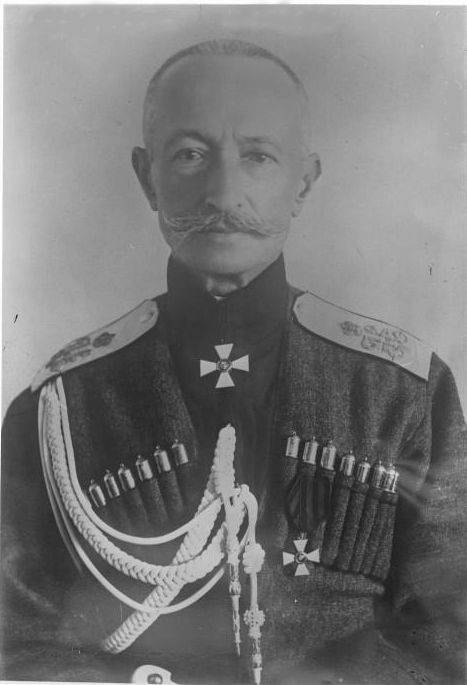
Commander of the 8 Army Alexey Alekseevich Brusilov
December offensive of the South-Western Front
The last operation of the 1915 campaign was the December offensive of the Southwestern Front troops. This offensive was undertaken in order to divert the enemy’s attention from Serbia, whose army at that time was engaged in unequal battles with Austrian, German and Bulgarian troops. In order to support Serbia in November, a new 7 Army was formed under the command of General Shcherbachev (4,5 Infantry and 1 Cavalry Corps).
There were several options for assistance to Serbia: the invasion of Bulgaria through Romania; joint offensive, as proposed by the Russian Stavka, to the Budapest 10 Russian corps through the Carpathians and the Anglo-French 10 through Thessaloniki; landing on the Bulgarian Black Sea coast; a strong blow to the left flank of the South-Western Front, in order to pull the Austro-Germans here and ease the position of the Serbs. The first option was rejected, as the Romanians refused to let the Russian troops through their territory, and did not want to push Romania into the camp of the Central Powers. The second option was rejected by the Allies. The third option did not please the naval command: the landing operation in the late autumn, with the presence of German naval forces in the Black Sea and without a naval base in Constance, was an extremely risky step.
Only the last option remained. 7 th army in December transferred to the area Trembovlya - Chortkov. The army of Shcherbachev was to attack the enemy with the assistance of the neighboring - 11 th Lechitsky (right) and 9 th Sakharov (left) - armies on the river. Strypa, developing its breakthrough in the north and north-west. On the part of the Central Powers, the new German army of Bothmer and the 7-I of Austria of Pflänzer were holding up this area. In general, the Austro-German troops were slightly weaker than the Russian forces attacking them.
The front command did not believe in the success of the operation. The front did not transfer the front reserves - 7 corps to the 2 army. Suddenly, the enemy will repel the blow and go on the offensive? The 11-I and 8-I armies were instructed not to take action until the 7-I army achieved any visible success. But only to produce demonstrations by artillery and searches for scouts. At the same time ordered to protect shells. Brusilov argued again, said that such a demonstration would do nothing, offered to deliver an auxiliary blow, to truly distract the enemy. However, he was banned.
The commander of the 7-th Russian army acted standard. On the offensive section of 25 km, he deployed his 3 corps, giving the flanking corps the 10 km sections of attack, and the middle one, which delivered the main attack, the 5 km section, leaving the fourth corps in reserve. The Austro-German command had against the 7 of the Russian army 4-5 divisions of the Austro-Germans, which occupied well-fortified positions. That is, the forces were approximately equal. The advantages of attacking Russian troops did not have.
However, the Austrians did not notice the training of Russian troops. It was believed that in the winter active battles will not be. December 27 3 Corps 9 Army auxiliary blow, but did not achieve success. December 29 3 Corps 7 Army went on the offensive. Within three days, they took three lines of fortifications, advanced 20-25 km, reached the line of the Strypa River.
But the offensive took place under the most disgusting climatic conditions: sleet, mud and off-road. Ammunition was scarce, and the artillery was soon silenced. Snow drifts did not allow to bring ammunition. The guns got stuck in the mud. Soldiers used to walk to the waist in wet snow and mud. The army had no reserves to develop. The Austro-German command, not seeing the threat from the 11 and 8 armies, pulled the troops to the place of the planned breakthrough, began to build a new defense. Brusilov reported on this to Ivanov, offered to attack before it was too late. But he was again refused.
In the meantime, fierce oncoming battles were already on Strype. Austro-German troops counterattacked. Heights passed from hand to hand several times, soldiers converged into hand-to-hand. The Austro-German troops, like the Russians, could not pull up the artillery, which gave them an advantage because of off-road. Both sides suffered huge losses. Under these conditions, Alekseev stopped this aimless operation on January 26.
The front on the Stryp has stabilized, there has been a long lull. Serbia could not help. Russian troops lost 50 thousand people. Germans and Austrians are about the same. The front command accused Shcherbachev of failure. Shcherbachev blamed Ivanov’s com-front and headquarters.
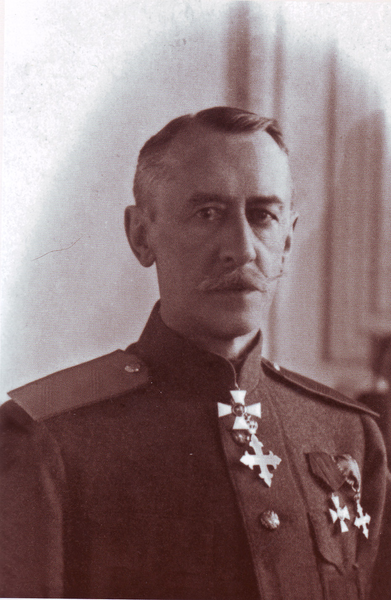
The commander of the 7 Army Dmitry Grigorievich Shcherbachev
Summary results
The 1915 campaign on the Russian front led to the collapse of the Central Powers plan to withdraw Russia from the war. The successes of the Austro-German troops in a number of operations did not change anything in the strategic position of the Central Powers. Germany and Austria-Hungary were increasingly experiencing a shortage of raw materials. The war dragged on, and in this situation Germany was doomed, since it was under blockade and did not have vast expanses and resources of Russia, the colonial empires of England and France. Germany was unable to victorious campaign and expand the circle of allies - at the expense of Italy, Bulgaria and Romania. Italy opposed Austria. Romania chose to maintain neutrality. Only Bulgaria acted on the side of Germany and Austria.
The great retreat is over. In five months our troops lost Galicia, Poland, Lithuania, the west of Belarus and the south of Latvia. The main reasons for the defeat of the Russian army were two. Firstly, the Russian military-political leadership failed to properly prepare the country, the armed forces, the economy and the people for a major war of attrition. Secondly, England and France consistently implemented the strategy of waging war with Germany "until the last Russian soldier." Russia in 1915 had to fight a powerful one-on-one enemy. The British and French did nothing to help an ally. Their troops on the Western Front were almost inactive. It was not until autumn that the Western Allies launched an offensive in Artois and Champagne, which did not change the strategic situation. This allowed the German command for a long time to conduct offensive operations against the Russian army and to send reinforcements to the Eastern front from the West.
The Russian army, which took upon itself and withstood the concentrated blows of the Austro-German army, provided Britain and France with a strategic temporary respite necessary for the accumulation of forces and means, the transfer of countries and armed forces to the “rails” of a protracted war, which ultimately predetermined the victory of the Entente.
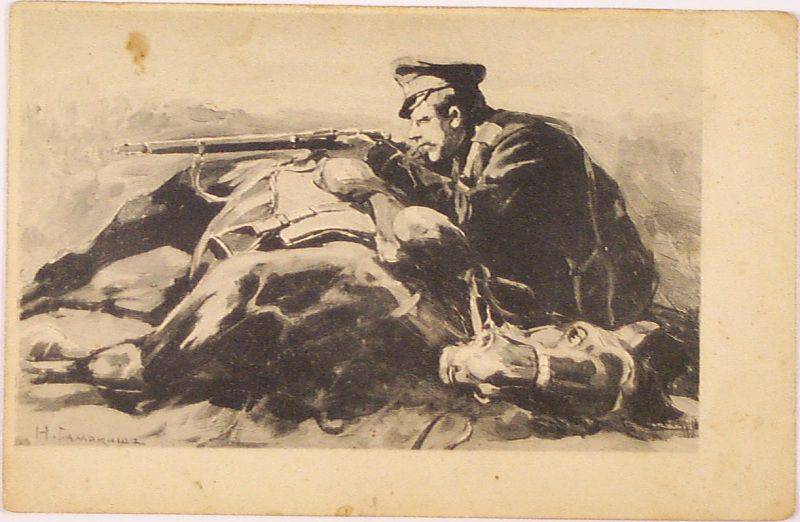
- Alexander Samsonov
- 1915 Campaign
Military plans of the Entente and the Central Powers for 1915 year
Death of the 20 Russian Corps
"Rubber War" in the Carpathians
Battle for Prasnysh
Italian "jackal" enters the war
Battle of the Isonzo
Second Battle of the Isonzo
Germany turns east
Bosphorus bait for Russia
Gorlitsky breakthrough
The defeat of the 3 Army Radko-Dmitriev. The death of the 48 "Steel" division of General Kornilov
Departure of Russian armies from Galicia. Loss of Przemysl and Lviv
The great retreat of the Russian army
The fall of Warsaw
Fall of the Newgeorg Fortress
The great retreat of the Russian army was the harbinger of the 1917 disaster of the year.
1915 Campaign of the Year on the Caucasus Front
Solution of the “Christian Question” in Turkey during the First World War
Battle for van
Alashkert operation
Hamadan operation
Sventsian breakthrough
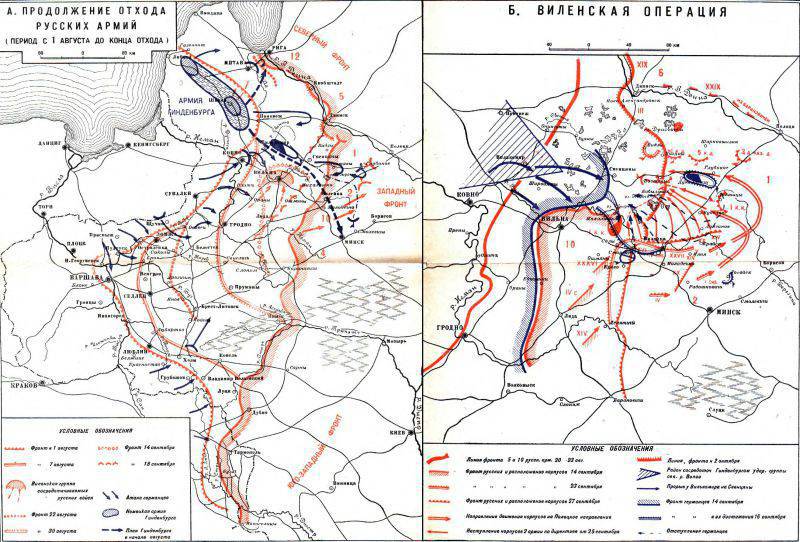
Information